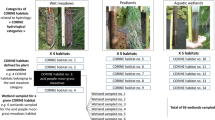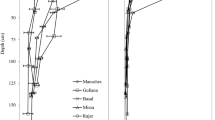Abstract
In January 2001, we surveyed streams and ponds above 300 m a.s.l. in Taylor Valley, South Victoria Land, Antarctica. One pond was examined in detail. Organic materials covered nearly 100% of the adjacent soil to 5–20 m from the shore, with intermittent patches to 80 m. Organic matter averaged 257 g C/m2, and totaled 1,388 kg organic C on the soil around the pond. Soil-moisture content (0.56–12.41%) decreased with distance from shore, whereas pH (7.8–10.8) increased with distance. Electrical conductivity was lowest in the soils <10 m from the pond (416±94 µS/cm). Mineral soil organic C and total N concentrations were greatest between 10 and 30 m from the edge of the pond (1.21±0.37 and 0.13±0.05 mg/g soil, respectively). Soil invertebrates were present in only 50% of samples and included tardigrades, rotifers, and two nematodes, Scottnema lindsayae and Plectus antarcticus. A non-parametric, discriminant function analysis based on soil moisture, soil organic carbon, and electrical conductivity correctly predicted 87.0% of sites that had invertebrates and 70.8% of sites for which invertebrates were absent. Tardigrades, rotifers, and P. antarcticus were found only in the wettest soils nearest the pond whereas S. lindsayae was restricted to drier soils further from shore. Other ponds and streams also showed substantial accumulations of organic matter, suggesting that upland wetlands serve as resource islands in these polar deserts that provide a source of organic matter to nearby soils.







Similar content being viewed by others
References
Adams EE, Priscu JC, Fritsen CH, Smith SR, Brackman SL (1998) Permanent ice covers of the McMurdo Dry Valley Lakes, Antarctica: bubble formation and metamorphism. Am Geophys Union Antarct Res Ser 72:281–295
Bomblies A, McKnight DM, Andrews ED (2001) Retrospective simulation of lake-level rise in Lake Bonney based on recent 21-yr record: indication of recent climate change in the McMurdo Dry Valleys, Antarctica. J Paleolimnol 25:477–492
Burkins MD, Virginia RA, Chamberlain CP, Wall DH (2000) Origin and distribution of soil organic matter in Taylor Valley, Antarctica. Ecology 81:2377–2391
Burkins MD, Virginia RA, Wall DH (2001) Organic carbon cycling in Taylor Valley, Antarctica: quantifying soil reservoirs and soil respiration. Global Change Biol 7:113–125
Campbell IB, Claridge GGC, Campbell DI, Balks MR (1998) The soil environment of the McMurdo Dry Valleys, Antarctica. Am Geophys Union Antarct Res Ser 72:297–322
Charley JL, West NE (1975) Plant-induced soil chemical patterns in some shrub-dominated semidesert ecosytems of Utah. J Ecol 63:945–964
Conovitz PA, McKnight DM, MacDonald LH, Fountain AG, House HR (1998) Hydrologic processes influencing streamflow variation in Fryxell Basin, Antarctica. Am Geophys Union Antarct Res Ser 72:93–108
Courtright EM, Wall DH, Virginia RA (2001) Determining habitat suitability for soil invertebrates in an extreme environment: the McMurdo Dry Valleys, Antarctica. Antarct Sci 13:9–17
Doran PT, Priscu JC, Lyons WB, McKnight DM, Fountain AG, Virginia RA, Wall DH, Parsons AN, McKay CP, Clow GD, Moorhead D, Fritzen CH (2002) Recent climate cooling and ecosystem response in the McMurdo Dry Valleys, Antarctica. Nature 415:517–520
Fountain AG, Burkins MB, Dana GL, Lewis KJ, Lyons WB, McKnight DM, Moorhead D, Parsons AN, Priscu JC, Wall DH, Wharton RA Jr, Virginia RA (1999) Physical controls on the Taylor Valley ecosystem, Antarctica. Bioscience 49:961–971
Freckman DW, Virginia RA (1993) Extraction of nematodes from Dry Valley Antarctic soils. Polar Biol 13:483–487
Freckman DW, Virginia RA (1997) Low diversity Antarctic soil nematode communities: distribution and response to disturbance. Ecology 78:363–369
Freckman DW, Virginia RA (1998) Soil biodiversity and community structure in the McMurdo Dry Valleys, Antarctica. Am Geophys Union Antarct Res Ser 72:323–335
Fritsen CH, Adams EE, McKay CP, Priscu JC (1998) Permanent ice covers of the McMurdo Dry Valleys Lakes, Antarctica: liquid water contents. Am Geophys Union Antarct Res Ser 72:269–280
Fritsen CH, Grue AM, Priscu JC (2000) Distribution of organic carbon and nitrogen in surface soils in the McMurdo Dry Valleys, Antarctica. Polar Biol 23:121–128
Fritsen CH, Priscu JC (1998) Cyanobacterial assemblages in permanent ice covers on Antarctic lakes: distribution, growth rate, and temperature response of photosynthesis. J Phycol 34:587–597
Hawes I, Howard-Williams C (1998) Primary production processes in streams of the McMurdo Dry Valleys, Antarctica. Am Geophys Union Antarct Res Ser 72:129–140
Hawes I, Moorhead D, Sutherland D, Schmeling J, Schwarz A-M (2001) Benthic primary production in two perennially ice-covered Antarctic lakes: comparisons of annual accumulation predicted from photosynthesis models with estimates from internal growth markers. Antarct Sci 13:18–27
Howard-Williams C, Vincent WF (1989) Microbial communities in southern Victoria Land streams (Antarctica). I. Photosynthesis. Hydrobiologia 172:27–38
Howard-Williams C, Vincent CL, Broady PA, Vincent WF (1986) Antarctic stream ecosystems: variability in environmental properties and algal community structure. Int Rev Ges Hydrobiol 71:511–544
Kennedy AD (1993) Water as a limiting factor in the Antarctic terrestrial environment: a biogeographical synthesis. Arct Alp Res 25:308–315
Lewis KJ, Fountain AG, Dana GL (1998) Surface energy balance and meltwater production for a Dry Valley glacier, Taylor Valley, Antarctica. Ann Glaciol 27:603–609
Lewis KJ, Fountain AG, Dana GL (1999) How important is terminus cliff melt?: a study of the Canada Glacier terminus, Taylor Valley, Antarctica. Global Planet Change 22:105–115
McKnight D, Alger A, Tate CM, Shupe G, Spaulding S (1998) Longitudinal patterns in algal abundance and species distribution in meltwater streams in Taylor Valley, Southern Victoria Land, Antarctica. Am Geophys Union Antarct Res Ser 72:109–127
McKnight DM, Niyogi DK, Alger AS, Bomblies A, Conovitz PA, Tate CM (1999) Dry Valley streams in Antarctica: ecosystems waiting for water. Bioscience 49:985–995
Moorhead DL, Priscu JC (1998) Organization, controls, and linkages in ecosystem processes in a polar desert: the McMurdo Dry Valleys, Antarctica. Am Geophys Union Antarct Res Ser 72:351–363
Moorhead DL, Davis WS, Wharton RA (1997) Carbon dynamics of aquatic microbial mats in the Antarctic dry valleys: a modelling synthesis. In: Lyons WB, Howard-Williams C, Hawes I (eds) Ecosystem processes in Antarctic ice-free landscapes. Balkema, Rotterdam, pp 181–196
Nienow JA, Friedmann EI (1993) Terrestrial lithophytic (rock) communities. In: Friedmann EI (ed) Antarctic microbiology. Wiley, New York, pp 343–412
Noy-Meir I (1973) Desert ecosystems: environment and producers. Ann Rev Ecol Syst 4:25–51
Parker BC, Simmons GM, Wharton RA Jr, Seaburg KA, Love FG (1982) Removal of organic and inorganic matter from Antarctic lakes by aerial escape of bluegreen algal mats. J Phycol 18:72–78
Powers LE, Freckman DW, Virginia RA (1995) Spatial distribution of nematodes in polar desert soils of Antarctica. Polar Biol 15:325–333
Powers LE, Ho M, Freckman DW, Virginia RA (1998) Distribution, community structure, and microhabitats of soil invertebrates along an elevational gradient in Taylor Valley, Antarctica. Arct Alp Res 30:133–141
Priscu JC, Fritsen CH, Adams EE, Giovannoni SJ, Paerl HW, McKay CP, Doran PT, Gordon DA, Lanoil BD, Pickney JL (1998) Perennial Antarctic lake ice: an oasis for life in a polar desert. Science 280:2095–2098
Reynolds JF, Virginia RA, Kemp PR, deWoyza AG, Tremmel DC (1999) Impact of drought on desert shrubs: effects of seasonality and degree of resource island development. Ecol Monogr 69:69–106
Runkel RL, McKnight DM, Andrews ED (1998) Analysis of transient storage subject to unsteady flow: diel flow variation in an Antarctic stream. J N Am Benthol Soc 17:143–154
SAS (1999) SAS Institute, version 8. Cary, NC
SPSS (1998) SPSS, version 9. Chicago, Ill
Squyres SW, Anderson DW, Nedell SS, Wharton RA Jr (1991) Lake Hoare, Antarctica: sedimentation through a thick perennial ice cover. Sedimentology 38:363–379
Torii T, Nakaya S, Matsubaya O, Matsumoto GI, Masuda N, Kawano T, Murayama H (1989) Chemical characteristics of pond waters in the Labyrinth of southern Victoria Land, Antarctica. Hydrobiologia 172:255–264
Treonis AM, Wall DH, Virginia RA (1999) Invertebrate biodiversity in Antarctic Dry Valley soils and sediments. Ecosystems 2:482–492
Virginia RA, Jarrell WM (1983) Soil properties in a mesquite-dominated Sonoran desert ecosytem. Soil Sci Soc Am J 47:138–144
Virginia RA, Wall DH (1999) How soils structure communities in the Antarctic Dry Valleys. BioScience 49:973–983
Wall DH, Virginia RA (1999) Controls on soil biodiversity: insights from extreme environments. Appl Soil Ecol 13:137–150
Wharton RA Jr, Mckay CP, Simmons GM Jr, Parker BC (1985) Cryoconite holes on glaciers. BioScience 35:499–503
Wilson AT (1965) Escape of algae from frozen lakes and ponds. Science 46:376
Acknowledgements
We thank K. Catapano and K. Levigne for assistance with soil processing, and K. Doggett and the Crary Analytical Laboratory staff for analytical support. Financial support for this work was provided by grants from the United States National Science Foundation OPP-0096250 and INT-9804949.
Author information
Authors and Affiliations
Corresponding author
Rights and permissions
About this article
Cite this article
Moorhead, D.L., Barrett, J.E., Virginia, R.A. et al. Organic matter and soil biota of upland wetlands in Taylor Valley, Antarctica. Polar Biol 26, 567–576 (2003). https://doi.org/10.1007/s00300-003-0524-x
Received:
Accepted:
Published:
Issue Date:
DOI: https://doi.org/10.1007/s00300-003-0524-x




